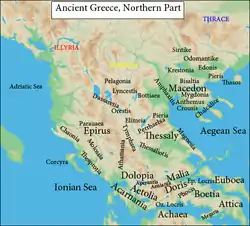Parauaea
Parauaea (Greek: Παραυαία) was an ancient Greek territory in the region of Epirus.[1] The inhabitants of the area were known as Parauaioi (Greek: Παραυαῖοι; also known as Parauaei or Parauaeans), a Thesprotian Greek tribe whose name meant "those dwelling beside" the Aous river.[2]

History
At the beginning of the Peloponnesian War (429 BC), the Parauaei under the leadership of king Oroidos (Greek: Ὄροιδος) joined forced together with the nearby Orestae as allies of Sparta against Acarnania.[3] That time they were more loosely associated with the adjacent tribes of the Molossians and the Atintanes.[3]
In 350 BC, Parauaea was incorporated into the Greek kingdom of Macedon as part of Upper Macedonia.[4][5] Later in 294 BC, the area was under the control of Pyrrhus of Epirus.[1] In the 3rd century BC, they are described as a "Thesprotian nation/tribe" by Rhianus and by Stephanus of Byzantium (6th century AD) quoting Rhianus.[6][7]
Location
Parauaea was among the northern Epirote tribal region in antiquity.[8]
See also
References
Citations
- Franke 1989, p. 461: "In 294, as the price of his help, Pyrrhus was given the region of Ambracia in southern Epirus, Acarnania, Amphilochia and the regions of Tymphaea and Parauaea in the border country between Epirus and Macedonia."
- Hammond 1967, p. 703: "The Parauaei and the Celaethi held their Thesprotian name from a period which goes back to a time before [...]"
- Hatzopoulos 2020, pp. 43-44, 227: Oroidos king of the Paraeauoi....Taking into consideration that in the passage from Thucydides the Parauaioi are directly coupled with the Orestai and connected more loosely with the Molossoi and the Atintanes...
- Plutarch (ed. Bernadotte Perrin). Pyrrhus, 6: "[...] demanded as a reward for his alliance Stymphaea and Parauaea in Macedonia [...]"
- Smith 1873, Pyrrhus: "These were Acarnania, Amphilochia, and Ambracia, and likewise the districts of Tymphaea and Parauaea, which formed part of Macedonia itself. (Plut. Pyrrh. 6, with the emendation of Niebuhr, Hist. of Rome vol. iii. note 811, Παραναίαν instead of Παραλίαν.)"
- Rhianus. Fragmenta, "Παραυαῖοι ἔθνος Θεσπρωτικόν".
- Smith 1854, PARAVAEI.
- Dieterle 2007, pp. 8–9: "Epirus gliedert sich in drei Regionen: Nord-, Zentral- und Südepirus. Die Stammesgebiete von Nordepirus (Chaonia, Atintania und Parauaia) liegen in heutigen Albanien, während sich Zentral- und Südepirus in die Stammesgebiete Molossis (um den See von Ioannina), Thesprotia (an der Küste südlich des Thyamis und um den Acheron) und Kassopeia (südwestlicher Teil von Epirus) austeilen lassen."
Sources
- Dieterle, Martina (2007). Dodona: religionsgeschichtliche und historische Untersuchungen zur Entstehung und Entwicklung des Zeus-Heiligtums (in German). Zurich and New York: Georg Olms Verlag Hildesheim. ISBN 978-3-487-13510-6.CS1 maint: ref=harv (link)
- Franke, P. R. (1989). "CHAPTER 10 PYRRHUS". In Astin, A. E.; Walbank, F. W.; Frederiksen, M. W.; Ogilvie, R. M.; Drummond, A. (eds.). The Cambridge Ancient History: The Rise of Rome to 220 BC. VII, Part 2. Cambridge: Cambridge University Press. pp. 456–485. ISBN 0-521-23446-8.CS1 maint: ref=harv (link)
- Hammond, Nicholas Geoffrey Lemprière (1967). Epirus: The Geography, the Ancient Remains, the History and the Topography of Epirus and Adjacent Areas. Oxford: The Clarendon Press.CS1 maint: ref=harv (link)
- Hatzopoulos, M. B. (2020). Ancient Macedonia. Walter de Gruyter GmbH & Co KG. ISBN 978-3-11-071868-3.
- Smith, William (1854). Dictionary of Greek and Roman Geography. London: Walton and Maberly.CS1 maint: ref=harv (link)
- Smith, William (1873). A Dictionary of Greek and Roman Biography and Mythology. London: John Murray.CS1 maint: ref=harv (link)